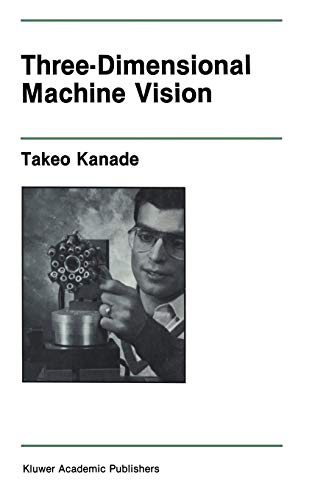Forum Legend
Member
LEVEL 1
45 XP

Free Download Three-Dimensional Machine Vision by Takeo Kanade
English | PDF | 1987 | 609 Pages | ISBN : 0898381886 | 41.9 MB
A robot must perceive the three-dimensional world if it is to be effective there. Yet recovering 3-D information from projected images is difficult, and still remains the subject of basic research. Alternatively, one can use sensors that can provide three-dimensional range information directly. The technique of projecting light-stripes started to be used in industrial object recognition systems as early as the 1970s, and time-of-flight laser-scanning range finders became available for outdoor mobile robot navigation in the mid-eighties. Once range data are obtained, a vision system must still describe the scene in terms of 3-D primitives such as edges, surfaces, and volumes, and recognize objeCts of interest.
Today, the art of sensing, extracting features, and recognizing objects by means of three-dimensional range data is one of the most exciting research areas in computer vision.
Three-Dimensional Machine Vision is a collection of papers dealing with three-dimensional range data. The authors are pioneering researchers: some are founders and others are bringing new excitements in the field. I have tried to select milestone papers, and my goal has been to make this book a reference work for researchers in three-dimensional vision.
The book is organized into four parts: 3-D Sensors, 3-D Feature Extractions, Object Recognition Algorithms, and Systems and Applications. Part I includes four papers which describe the development of unique, capable 3-D range sensors, as well as discussions of optical, geometrical, electronic, and computational issues. Mundy and Porter describe a sensor system based on structured illumination for inspecting metallic castings. In order to achieve high-speed data acquisition, it uses multiple light stripes with wavelength multiplexing. Case, Jalkio, and Kim also present a multi- stripe system and discuss various design issues in range sensing by triangulation. The numerical stereo camera developed by Altschuler, Bae, Altschuler, Dijak, Tamburino, and Woolford projects space-coded grid patterns which are generated by an electro-optical programmable spatial light modulator. Kanade and Fuhrman present a proximity sensor using multiple LEDs which are conically arranged. It can measure both distance and orientation of an object's surface.
Buy Premium From My Links To Get Resumable Support,Max Speed & Support Me
FileBoom
9186e.rar
Rapidgator
9186e.rar.html
NitroFlare
9186e.rar
Uploadgig
9186e.rar
Fikper
9186e.rar.html
Links are Interchangeable - Single Extraction
DownGX's SIGNATURE
